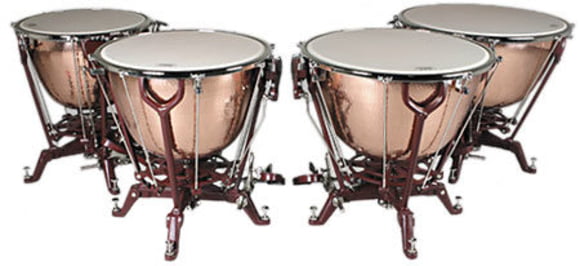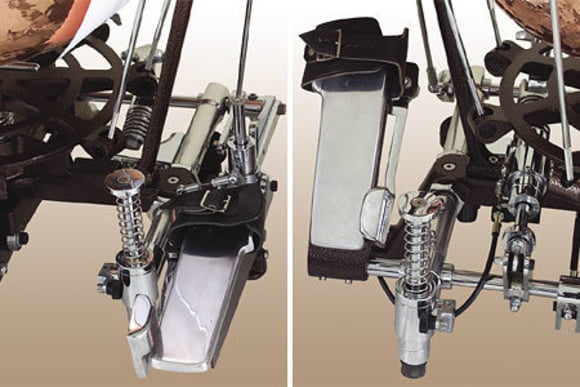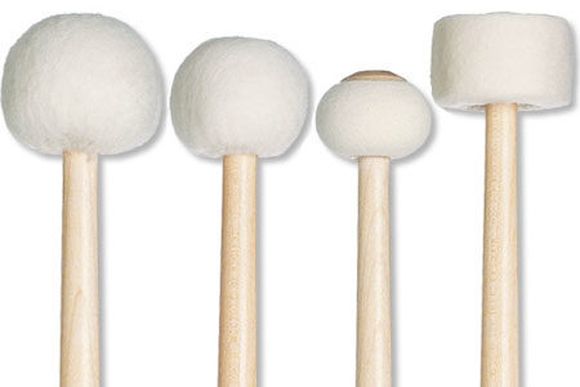7. Kettle Drums/Timpani
Kettle Drums (also known as timpani/tympani or timps) are used in symphony orchestras throughout the world. They have an instantly recognizable resonant, sustaining sound. Timpani are often used in pairs or larger sets, with different diameters suitable for different pitch ranges.
There are two common methods for orienting the drums: the German method and the international method. The international standard places the largest drum to the left; the German method reverses this. Most of the world except for German-speaking countries uses the international method. If the pitch pedal is placed at the centre of each drum, kettle drums can be easily placed in either orientation.
How many drums do I need for my ensemble?
There is no easy answer to this question since the piece determines the number of drums required. A small chamber orchestra playing pieces by Mozart, Haydn and Beethoven can get away with two timps of approximately 26 and 29 inches in diameter. For a larger orchestra, four drums is advisable. Some pieces require as many as eight, which puts great demands on the player as well as the orchestras budget. For most orchestras, four or five drums will suffice.

Kettle materials and their sound
The shape of the timpani bowl affects the sound. Parabolic-shaped bowls offer darker timbres while hemispheric bowls are brighter sounding. Kettle bowls are usually made from either copper or fibreglass; fibreglass bowls are less expensive to manufacture. Fibreglass bowls offer lots of volume while copper bowls offer a rich, resonant tone and are preferred for professional use. Copper bowls tend to be heavier than fibreglass bowls. So prior to purchasing timpani, ask yourself if you plan to transport them yourself - if so, fibreglass may be a more desirable choice. Copper bowls may either be smooth or hammered; hammering improves the sound of timpani by reducing the slight pitch fall-off and wavering that smooth-shelled drums may exhibit.
Pedal Systems

The pedals are used to quickly change the tuning of kettle drums. Most professional timpani employ the Dresden (right photo) type of pedal system though some use the Berlin (left photo) post and clutch system. Some less expensive models use a chain that goes around the drum to change the pitch. Cheaper models offer other simplified systems that serve the same purpose.
Heads
Timpani heads are made either from natural animal skin or synthetic materials. While many older timpanists prefer natural skins for their warm timbres, their susceptibility to humidity makes them a difficult choice to recommend. Synthetic heads have improved greatly in recent years and offer great benefits in terms of cost, consistency and availability. These heads tend to have a brighter tone but manufacturers are always working to improve this. Timpani heads are sized differently than snare and drum set heads, whose designation corresponds to the diameter of the shell. A 14-inch snare drum head is slightly larger than 14-inches but fits on a 14-inch drum shell. A 23-inch timp will require a head closer to 25 inches in diameter.
Mallets

A very wide selection of mallets is available to the modern timpanist. Most have in common wooden handles and felt covered heads of varying degrees of hardness. Some timpani mallets use different woods for their handles and some expensive models even use bamboo. Every timpanist should have at least three pairs of mallets in varying degrees of hardness: soft, medium and hard. Soft mallets are useful for rolling passages; harder mallets are useful for articulating quick rhythmic passages but are not as suitable for obtaining smooth rolls. Mallets of medium hardness are a good choice for musical passages that require both effects. The softness or hardness of the head, the shaft material and the size and shape of the mallet head all affect the timbre produced.
Your Contacts
Product Highlights
Offers
-
Xylophones
-
Metallophones
-
Marimbas
-
Vibraphones
-
Tubular Bells
Recommended categories
Do you like what you're seeing?






